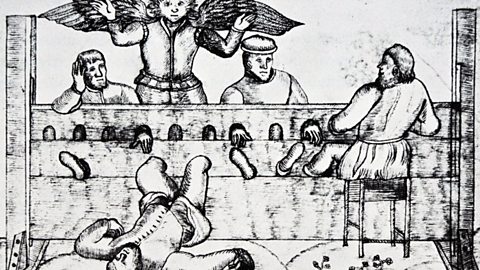The use of public corporal punishment up to the 19th century
Stocks and pillory

These were used to punish people for crimes such as swearing or drunkenness. Criminals would sit or stand at a wooden frame and the local people would throw rotten food or even stones at them.
The stocks and pillory were used as a punishment throughout the 16th and 17th centuries. Their use declined in the 18th century. It is thought that the last time the stocks were used in Wales was in 1872 in Newcastle Emlyn.
Flogging
Flogging was a common punishment in Tudor and Stuart times. It was used for crimes such as refusing to attend church, and stealing, and vagrants were publicly flogged.
Flogging continued to be a sentence that could be passed by courts until the mid-20th century, though not for non-attendance at church or vagrancy.
Public punishments in Wales
In addition to the punishments used in England such as stocks, pillory, flogging and execution, Wales also had its own unique type of public punishment.
Ceffyl pren is Welsh for wooden horse. It was a form of corporal punishment used in parts of rural Wales, usually for men accused of wife beating, adultery or refusing to marry a girl they had got pregnant. It was a form of community punishment. It is thought that it was used right up until the 1840s.
It is thought that the Rebecca Rioters used Ceffyl pren on informers and gatekeepers. Offenders would be paraded around the village tied to a wooden frame or ladder. This was humiliating and often painful.
Scotch Cattle were a vigilante group active in industrial areas in the early 19th century. Scotch Cattle gangs punished those who had worked during a strike. The Scotch Cattle would dress in disguise and visit the homes of blackleggerA person who works in place of someone engaged in a strike. or strike breakers. They would blow horns and rattle chains, then break doors and smash furniture in the house. If people resisted, they would be beaten.